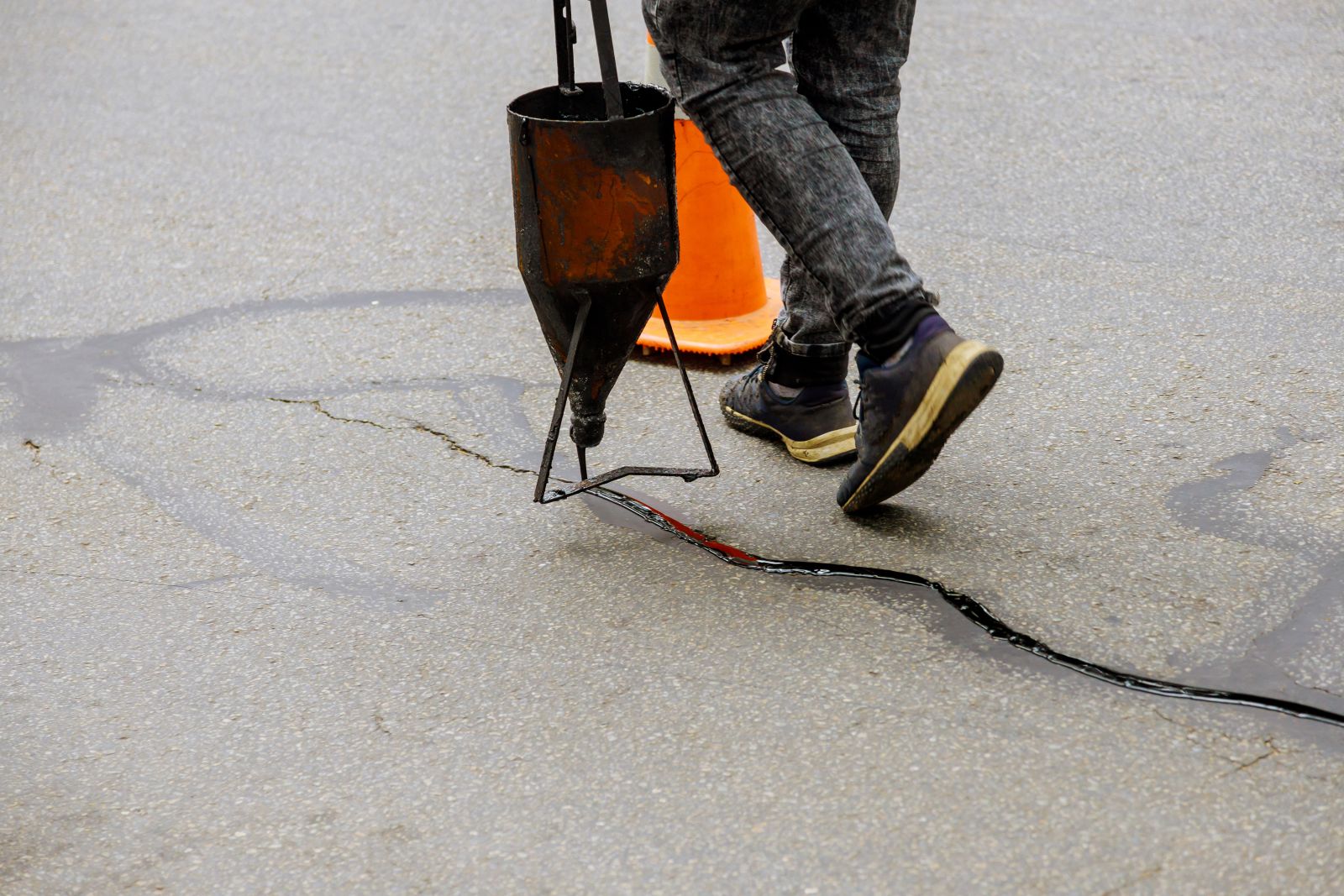Blog

How to Fix Cracks in an Asphalt Driveway: Ensure Long-Lasting Repairs with Roof Maintenance
One of the most common issues homeowners face is cracks in their asphalt driveway. Over time, weather, traffic, and general wear and tear can cause these cracks to form. While small cracks may seem like a minor problem, ignoring them can lead to more severe damage down the line, such as potholes or complete driveway deterioration. The good news? Fixing cracks in your asphalt driveway is not only manageable, but it can also extend the life of your driveway by years with the right asphalt repair techniques.
But while focusing on driveway repairs, don’t overlook another essential part of your home’s exterior—your roof. Tackling roof repair alongside asphalt maintenance ensures your entire property is protected against water damage and weathering. A well-maintained roof complements your repaired driveway, creating a cohesive, polished look for your home.
In this comprehensive guide, we'll walk you through everything you need to know about asphalt driveway crack repair, including the types of cracks you might encounter, the materials and tools you'll need, and a detailed step-by-step process for a professional-quality repair.
Why Do Asphalt Driveways Crack?
Before we dive into the solution, it's essential to understand the root causes of cracks in asphalt. Cracks often develop due to environmental factors and normal wear and tear. Here's a breakdown of the most common reasons:
1. Weather and Temperature Fluctuations
Asphalt expands and contracts with temperature changes. In the summer, the heat can cause the asphalt to expand, while in the winter, it contracts as temperatures drop. These expansions and contractions put stress on the asphalt, eventually causing cracks to form.
2. Water Penetration
When water seeps into the cracks and freezes, it expands, pushing the asphalt apart. This freeze-thaw cycle can significantly worsen small cracks over time.
3. Heavy Traffic
If your driveway is regularly exposed to heavy vehicles or large equipment, the additional weight can cause cracks, especially if the asphalt layer is too thin or the sub-base is not adequately compacted.
4. Aging
Like most materials, asphalt breaks down over time. As the asphalt oxidizes and loses its oils, it becomes more brittle and susceptible to cracking.
Expert Insight: "Asphalt is an incredibly durable material, but like any surface, it needs regular maintenance. Without proper upkeep, small cracks can turn into big problems that are more expensive to fix," says Tom Mitchell, a 25-year veteran in asphalt maintenance and repair.
Types of Asphalt Cracks and Their Solutions
Not all cracks are the same, and each type may require a slightly different repair method. Here's an overview of the most common types of cracks you might encounter:
1. Hairline Cracks
These are tiny cracks, typically less than 1/8 inch wide, caused by surface wear or minimal expansion. While not immediately dangerous, they can grow if left untreated.
Solution: A liquid crack filler or asphalt emulsion is perfect for sealing these tiny cracks and preventing water from seeping in.
2. Transverse and Longitudinal Cracks
These cracks run across or along the length of the driveway and are usually caused by temperature changes and asphalt fatigue.
Solution: Crack filler or rubberized crack sealer works well for these types of cracks, ensuring flexibility as the asphalt continues to expand and contract.
3. Alligator Cracks
Alligator cracks are characterized by a series of interconnecting cracks that resemble the scales of an alligator. They are often caused by poor sub-base or excessive loads.
Solution: Alligator cracking usually requires more extensive repair. A patch or full-depth asphalt replacement may be necessary, depending on the severity of the damage.
4. Edge Cracks
Edge cracks form along the perimeter of the driveway and are often caused by insufficient support at the edges or poor drainage.
Solution: Filling edge cracks with a quality crack filler or sealant is essential, but you may also need to address underlying issues such as drainage or adding support to the edges.
Step-by-Step Guide: How to Fix Cracks in Your Asphalt Driveway
Now that we've covered the types of cracks and their causes, let’s go step by step on how to fix them. The following process works best for minor to moderate cracks.
Materials and Tools You’ll Need:
- Crack filler (asphalt emulsion or rubberized filler)
- Asphalt patch (for larger cracks or alligator cracks)
- Crack cleaning brush or wire brush
- A broom or leaf blower
- A caulking gun (for applying the crack filler)
- A trowel or putty knife
- Protective gloves
Step 1: Clean the Area
Before you can apply any filler, it's crucial to clean the crack thoroughly. Use a wire brush to remove any dirt, debris, or loose asphalt from the crack. You can also use a broom or leaf blower to clear the surrounding area.
Tip: For deeper cracks, consider using a pressure washer to flush out dirt, but be sure to let the crack dry completely before proceeding.
Step 2: Prep the Crack
For cracks wider than 1/4 inch, it’s important to use a crack cleaning tool to ensure that the crack is free of loose material. Larger cracks may also need to be widened slightly with a chisel to create a uniform surface for the filler to adhere to.
Step 3: Apply Crack Filler
Now that the crack is clean and prepped, you can apply the crack filler. Most asphalt crack fillers come in a liquid form or caulk-like tube, making it easy to apply with a caulking gun.
- For small cracks: Pour or squeeze the filler directly into the crack until it’s slightly overflowing.
- For larger cracks: Use a rubberized filler or asphalt patch material and apply it in layers, using a trowel or putty knife to smooth it out.
Step 4: Smooth the Surface
After applying the filler, use your trowel or putty knife to smooth out the surface. This step is essential for ensuring an even, flush surface that will blend seamlessly with the rest of the driveway.
Real-Life Example: Jane, a homeowner in Illinois, noticed small cracks appearing on her asphalt driveway after a particularly harsh winter. By using a rubberized crack filler and following these steps, she was able to stop the cracks from spreading. "It was a weekend project, but well worth it when I saw how much money I saved in the long run," she shared.
Step 5: Let It Dry
Allow the crack filler to dry according to the manufacturer’s instructions. Drying time typically ranges from 24 to 48 hours, depending on weather conditions and the type of filler used.
Step 6: Apply a Sealcoat (Optional)
After your cracks are filled and the surface is dry, consider applying a sealcoat to your driveway. Sealcoating not only protects your asphalt from future damage but also gives it a fresh, uniform appearance. It’s recommended to sealcoat every 3 to 5 years to maximize the life of your driveway.
Preventative Maintenance: Keeping Your Asphalt Driveway in Top Shape
Fixing cracks is just one part of asphalt driveway maintenance. Regular care can prevent cracks from forming in the first place and prolong the life of your driveway. Here are some tips:
1. Sealcoating
As mentioned earlier, sealcoating provides a protective layer that shields the asphalt from UV rays, water, and chemicals. Regular sealcoating will keep your asphalt looking fresh and crack-free.
2. Proper Drainage
Ensure that your driveway has proper drainage to prevent water from pooling. Standing water can seep into small cracks and cause them to expand over time.
3. Avoid Heavy Loads
If your asphalt driveway wasn’t designed for heavy loads, try to avoid parking large vehicles or equipment on it regularly. The additional weight can cause premature cracking and deterioration.
When to Call a Professional
While DIY crack repairs can handle small to medium-sized cracks, some situations require professional intervention. If you’re dealing with severe alligator cracking, large potholes, or cracks that continue to grow despite repairs, it may be time to consult an asphalt contractor.
Expert Insight: "It’s tempting to tackle every repair on your own, but for significant damage, professional asphalt repair services can ensure the job is done right the first time, saving you from costly fixes down the road," advises Emily Rogers, an experienced asphalt repair contractor.
Conclusion: Fixing Cracks in Your Asphalt Driveway
Addressing cracks in your asphalt driveway as soon as they appear is essential for maintaining the integrity and appearance of your driveway. With the right materials and approach, you can tackle most crack repairs yourself, saving money and extending the life of your asphalt. However, staying on top of asphalt maintenance—such as sealcoating and ensuring proper drainage—will help prevent cracks from forming in the first place.
Whether you’re handling a few hairline cracks or dealing with more extensive damage, following the steps in this guide will help you achieve a professional-level repair. Don’t wait—tackle those cracks today, and keep your driveway looking pristine for years to come!








